Prehistoric China
The Wonders That Were Jiahu The World’s Earliest Fermented Beverage
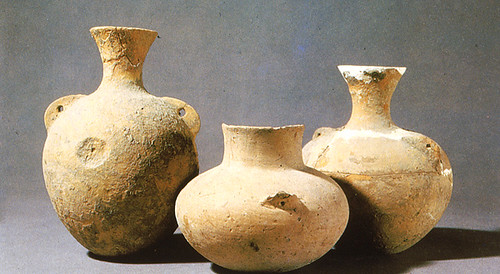
Early Neolithic jars, with high flaring necks and rims, from Jiahu (Henan province, China), ca. 6000-5500 B.C. Analyses by the author and his colleagues showed that such jars contained a mixed fermented beverage of rice, honey, and fruit (hawthorn fruit and/or grape). (Photograph courtesy of Z Juzhong, University of Science and Technology in China, and Henan Institute of Cultural Relics and Archaeology, nos. M252:1, M482:1, and M253:1 (left to right), height 20 cm. (leftmost jar).
The earliest chemically confirmed alcoholic beverage in the world was discovered at Jiahu in the Yellow River Valley of China (Henan province), ca. 7000-6600 B.C. (Early Neolithic Period). It was an extreme fermented beverage made of wild grapes (the earliest attested use), hawthorn, rice, and honey.
The Jiahu discovery illustrates how you should never give up hope in finding chemical evidence for a fermented beverage from the Palaeolithic period. Research very often has big surprises in store. You might think, as I did too, that the grape wines of Hajji Firuz, the Caucasus, and eastern Anatolia would prove to be the earliest alcoholic beverages in the world, coming from the so-called “Cradle of Civilization” in the Near East as they do. But then I was invited to go to China on the other side of Asia, and came back with samples that proved to be even earlier–from around 7000 BC. There, at the Neolithic site of Jiahu in the Yellow River valley, the people were making, enjoying, and using what is so far the earliest chemically attested fermented beverage in the world in their burial and religious ceremonies. Like Midas Touch, it was another take on an extreme fermented beverage, and it illustrates once again the hold that alcoholic beverages have on the human race.
Most importantly, China began making pottery earlier than in the Near East (as early as 13,000 BC versus 6000 BC), and this was crucial to our discovery. Pottery is virtually indestructible, and liquids are absorbed into the pores of the pottery. As a result, ancient organics are preserved for 1000’s of years until we come along to extract and analyze them.
The pottery that we analyzed from Jiahu were jars with high necks, flaring rims and handles, which were ideally shaped to hold and serve liquids. Again, we used a whole battery of chemical tests to ferret out the original beverage.
You could call this extreme beverage a “Neolithic grog.” It was comprised of honey mead and a combined “beer” or “wine” made from rice, grapes, and hawthorn fruit. Rice is a grain, like wheat and barley, so by that definition it makes a beer (of about 4-5% alcohol), but when it’s fermented to 9-10% and has pronounced aromatic qualities, then it’s more like a wine. Maybe, the best modern comparison is with an aged Belgian ale or a barley wine. Although some ingredients have been interchanged, it’s also not all that different from Midas Touch in combining a wine, beer and mead, even if Jiahu precedes Midas by some 6000 years.
One topic ripe for discussion is how did it happen that China now has the earliest chemically attested instance of grape being used in a fermented beverage? Of course, the use of grape this early–likely a wild Chinese species such as Vitis amurensis with up to 20% simple sugar by weight–came as a great surprise. As far as we know–but continued exploration may change the picture–none of some 40 grape species found in China, the highest concentration in the world, were ever domesticated. Yet, this is the earliest evidence of the use of grape in any fermented beverage. And high-sugar fruit, with yeast on its skins, is crucial in making the argument that the liquid in the vessels wasn’t just some kind of weird concoction but actually was fermented to alcohol by the yeast.
We don’t know at this point whether hawthorn fruit or grape alone or in combination were used. After we announced that these were the most likely fruits based on our chemical results, a study of the botanical materials at the site–a discipline that has recently begun to be practiced in China–seeds of just those two fruits and no others were found. Although not helping us to decide whether either or both were used for the beverage, this provided excellent corroboration for our findings.
Jiahu isn’t just your run-of the-mill early Neolithic site. For example, it has yielded the earliest playable musical instruments in the world. Three dozen flutes were made exclusively from one wing bone of the red-crowned crane. Traditional Chinese music, using the pentatonic scale, can be played on the flutes, as demonstrated by the flautist for Beijing’s Central Orchestra of Chinese Music has produced. The flutes might well have played a role, along with the fermented beverage, in ceremonies to the ancestors, just like music and rice and millet wines Egypt (see “Research on Egyptian Medicinal Wines”) were closely associated with ancestor worship at the fabulous Shang Dynasty capital cities, such as Anyang, from about 1600 to 1050 BC, and up to present.
Jiahu has also produced what are arguably the earliest Chinese written characters ever found, incised on tortoise shells like those that occur at the fabulous Shang Dynasty capital cities, such as Anyang, thousands of years later. Such inscribed shells are believed to have been used by shaman-like priests to predict and assure a good future. We don’t know if the Jiahu shells, assuming they bear some kind of early Chinese writing, have the same significance as later, but the hypothesis gains credibility from their association with the musical instruments and especially the mixed fermented beverage, all-important parts of later Chinese religious and funerary ceremonies.
One topic ripe for discussion is how did it happen that China now has the earliest chemically attested instance of grape being used in a fermented beverage? Of course, the use of grape this early–likely a wild Chinese species such as Vitis amurensis with up to 20% simple sugar by weight–came as a great surprise. As far as we know–but continued exploration may change the picture–none of some 40 grape species found in China, the highest concentration in the world, were ever domesticated. Yet, this is the earliest evidence of the use of grape in any fermented beverage. And high-sugar fruit, with yeast on its skins, is crucial in making the argument that the liquid in the vessels wasn’t just some kind of weird concoction but actually was fermented to alcohol by the yeast.
We don’t know at this point whether hawthorn fruit or grape alone or in combination were used. After we announced that these were the most likely fruits based on our chemical results, a study of the botanical materials at the site–a discipline that has recently begun to be practiced in China–seeds of just those two fruits and no others were found. Although not helping us to decide whether either or both were used for the beverage, this provided excellent corroboration for our findings.
We could debate whether the rice in the Jiahu beverage was wild or domesticated, and whether its starch was broken down by chewing or malting. Chewing or salivating a grain, stalk or tuber to break down its starches into sugar appears to the be earliest method that humans employed for preparing their beers around the world. An enzyme–ptyalin–in human saliva acts to cleave the larger molecules into simple sugars. In modern Japan and Taiwan, communities of women still gather around a common vessel, and chew and ferment rice wine for marriage celebrations.
However the rice was broken down and fermented, it still leaves lots of debris that floats to the surface, and the best way around that is to use a drinking-tube or straw, the time honored method to drink beer in ancient Mesopotamia and rice wine in a traditional village of south China.–what you might call extreme beverage-drinking.
The same extreme fermented beverage attested at Jiahu was still being made some 5000 years later, ca. 2400-2200 B.C., at the site of Liangchengzhen in Shandong province. Anne Underhill, now of Yale University, excavates this site with her Chinese colleagues. She first invited me to the site in 1999, and I took the opportunity to travel the country in search of ancient fermented beverages.
More recently, my laboratory’s analyses of ancient Chinese beverages been expanded to include samples from Erlitou and Huizi, in collaboration with and with funding from La Trobe University (Li Liu) and the Institute of Archaeology, Chinese Academy of Social Sciences (Xingcan Chen). Since Erlitou is believed to be the capital of the first Chinese dynasty (Xia), once thought to be purely legendary, it holds out the promise of filling in the beverage gap between the Longshan period of Liangchengzhen and the Shang Dynasty.
Related to this research, additional liquid samples of western Han date (ca. 260 B.C.-8 A.D.) from Xi`an, provided through contacts at the Freer Museum, were analyzed at Firmenich Inc., Princeton, NJ (flavors and fragrances). They turned up negative.
P. E. McGovern, A. P. Underhill, H. Fang, F. Luan, G. R. Hall, H. Yu, C.-s. Wang, F. Cai, Z. Zhao, and G. M. Feinman
2005 Chemical Identification and Cultural Implications of a Mixed Fermented Beverage from Late Prehistoric China. Asian Perspectives 44: 249-75.
P. E. McGovern, J. Zhang, J. Tang, Z. Zhang, G. R. Hall, R. A. Moreau, A. Nuñez, E. D. Butrym, M. P. Richards, C.-s. Wang, G. Cheng, Z. Zhao, and C. Wang
2004 Fermented Beverages of Pre- and Proto-Historic China. Proceedings of the National Academy of Sciences USA 101.51: 17593-9.
Archaeological Oncology
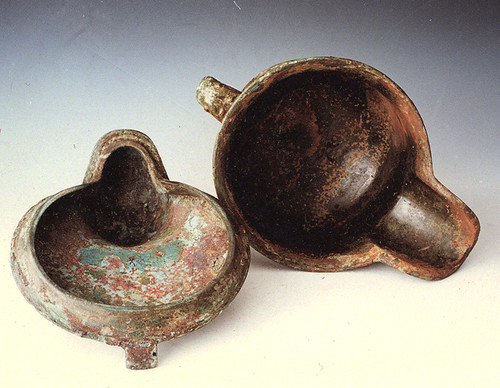 Lidded you jar from the Changzikou Tomb in Luyi county, Henan province, dated ca. 1250–1000 B.C.–here opened. (Photograph courtesy of Z. Zhang and Institute of Cultural Relics and Archaeology of Henan Province).
Lidded you jar from the Changzikou Tomb in Luyi county, Henan province, dated ca. 1250–1000 B.C.–here opened. (Photograph courtesy of Z. Zhang and Institute of Cultural Relics and Archaeology of Henan Province).
Wines Fit for Kings and the Afterlife
My laboratory, in collaboration with colleagues at Penn’s Abramson and Medical Centers, is now testing compounds in ancient fermented beverages for their anti-cancer and other medicinal properties in a new project called “Archaeological Oncology: Digging for Drug Discovery.” Our ancient ancestors had a huge incentive in trying to find any cure they could to cure mysterious diseases and extend their life spans beyond the usual 20-30 years. Over millennia, they might well have hit upon solutions, even if they couldn’t explain it scientifically. Superstition also crept in, but in certain periods, like the Neolithic, humans were remarkably innovative in domesticating and probably discovering medicinal plants. They were lost to future generations when the cultures collapsed and disappeared, but can now be rediscovered using Biomolecular Archaeology.
Prehistoric Egypt illustrates the phenomenon, which likely extends far back in the past, to the beginnings of our species. During Dynasty 0, around 3150 B.C., one of the first kings of Egypt, Scorpion I, was buried in a magnificent “funerary house” in the desert at Abydos on the middle Nile River.
The German Institute of Archaeology in Cairo excavated Scorpion’s tomb in all its splendor, with ivory scepter and supplies of food and drink to carry with him into the afterlife. What was most astounding was that 700 jars containing some 4500 liters of resinated wine, according to our chemical analyses, were deposited in these three rooms, which was then covered over by a roof and mound of earth.
The jars were filled with sand when they were found. Once the sand was poured out from each jar, rings of a yellowish crusty residue were revealed on the interiors of the jars. The rings or tide-lines were slanted off from the horizontal, and are best explained as the remains of a liquid that had gradually evaporated, with materials on the surface of the liquid agglomerating to form the rings. Some of the jars also contained something highly unusual that had never been seen before: figs had been sliced up and perforated to run a string through them so that they could be suspended from the mouth of the vessels into the liquid. The preservation of figs, more than 5000 years old, is quite amazing. It is not attested for any other ancient wine, although it might well have served as a sweetening or fermenting agent or special flavoring; by cutting up and stringing out the fig segments, more of the wine would come in contact the fruit.
Where had such a large quantity of for Scorpion I’s trip through eternity, come from? The extremely dry terrain of Abydos was an unlikely place to have transplanted the domesticated grapevine and produced wine. Moreover, the Eurasian grapevine never grew in Egypt until it was transplanted there and the basis of royal wine industry around 3000 B.C.
Our analyses by neutron activation analysis of the pottery comprising the jars themselves provided the answer. The tests showed that they were made from clays local to the Jordan Valley and the southern hill country to its west and Transjordan to the east. Assuming that the jars were made in the same places that the wine was produced, it is now clear that the wine deposited in the tomb of Scorpion at Abydos was transported some 500 to 700 miles, overland by donkey caravans, including the Sinai stretch (the so-called “Ways of Horus”) of ten days, and then probably by boat up the Nile. This scenario makes good sense, since we know that the Levantine winemaking industry had already been in existence for a thousand years.
What appears to be happening in the earliest stages of Egyptian history is that the rulers and upper classes began to import wine as a costly, prestige item, not unlike what goes on today when we serve that special bottle to friends–whether a Pétrus, a lush Priorat or Rioja wine, or Egyptian “Cleopatra,” still made in the Nile Delta. Even though it must have been like importing liquid gold, the Egyptian rulers at first had no choice but to procure the beverage from the nearby Levant with its well-established winemaking industry. The main impetus for this development was what can be called “elite emulation.” Wine and special wine-drinking vessels were given as gifts to kings and the upper class. The Pharoahs knew that rulers elsewhere in the Near East celebrated their victories with special wine-drinking ceremonies, offered wine to the gods as an evocative symbol of blood in their role as high priest, and stocked their tombs with the elixir. In imitation of this conspicuous consumption, one king after another adopted the wine culture.
Once the beverage had established an economic foothold, usually being incorporated into religious ritual and social custom as well, the next logical step was to transplant the grapevine itself, and begin producing wine locally to assure a more steady supply, at a lower cost and tailored to local tastes. The Nile Delta with its extensive tracts of irrigated land, sunny days and short rainy season was ideal, and became the focus of the royal wine industry in the first two dynasties.
Besides being resinated wine with terebinth tree resin to which fresh fruit (grapes and figs) had been added, the Scorpion wine had also been laced with a variety of herbs–mint, coriander and sage–according to our re-analysis of the jar residues, using state-of-the-art techniques in collaboration with the U.S. Government Tax and Trade Commission Laboratory (Beltsville, MD).
We have also demonstrated that the liquid in the jars had indeed been fermented, according DNA analysis in collaboration with the University of Florence. The residues revealed fragments of wine yeast DNA, Saccharomyces cerevisiae, the earliest ever recovered and the likely precursor of the bread and beer yeasts.
Egypt has one of the most ancient and detailed materia medica in the world, based on archaeobotanical findings and literary traditions. Papyri, dating back to the mid-12th Dynasty, ca. 1850 B.C., show that “medicinal wines” were very important to the Egyptian “physician” (swnw, the hieroglyphic word, is attested as early as Dynasty 3, ca. 2650 B.C.).
More than a thousand prescriptions are recorded in the ancient Egyptian medical papyri. Most numerous are those that list alcoholic beverages–wine and beer–as dispensing agents, and in which tree resins (terebinth, pine, frankincense, myrrh, fir, etc.) and numerous herbs (bryony, coriander, cumin, mandrake, dill, aloe, wormwood, etc.) are added ingredients. The plants and their exudates were macerated, mixed together, and steeped in these beverages; they were administered for specific ailments. Traditional Egyptian medicine today still uses many of the same formulations. Based on the continuity of Egyptian medicine over thousands of years, it is reasonable to project it further back into the past, to account for the biomolecular and archaeobotanical evidence from the Scorpion I wine jars.
Our earliest evidence of an alcoholic beverage from anywhere in the world, which might have been used medicinally, is from the Neolithic site of Jiahu in the Yellow River Valley of China, dating back to ca. 7000 B.C. Biomolecular archaeological analyses of pottery jars which contained the beverage showed that the ancient beverage had been formulated from rice, honey, a Chinese grape species, and hawthorn tree fruit. This finding is obviously of great interest for the history of Chinese medicine, which was already being written down in the earliest texts–the oracle bone inscriptions of the late Shang Dynasty (ca. 1200-1046 B.C.)–and then continued to develop over the next three millennia to become TCM. In recent decades, the latter has been put on a much more solid scientific basis. Since we have not yet analyzed the extracted residues from the Jiahu jars by the same techniques used recently for the Scorpion wine, it is not known whether any herbs or spices, which might have anticancer or other medicinal properties, were added to the ancient mixed beverage. Other than several well-known and studied anti-oxidant compounds from grape (e.g., resveratrol) and hawthorn fruit, our survey of the literature did not reveal any additional active anticancer compounds to be screened.
By Shang Dynasty times, however, herbs were clearly part of an already highly specialized medicinal wine “industry.” One wine (chang) was specifically denoted as herbal wine in the oracle bone inscriptions. Officials in the Shang palace administration were charged with making the beverages, which the king inspected. Our Thermal Desorption GC-MS analysis of liquid, amazingly still contained inside a lidded bronze jar (Fig. 2) from the Changzikou Tomb in Henan Province (ca. 1050 B.C., contemporaneous with the oracle bone inscriptions), illustrates what information can be gleaned via biomolecular archaeology. The tight lid on the jar accounts for the liquid having not evaporated: it had corroded to the neck, hermetically sealing off the jar’s contents until the tomb was excavated thousands of years later. What is equally amazing is that these “well-aged” liquids sometimes have the characteristic fragrance of a fine rice or millet wine made the traditional way, slightly oxidized like sherry but also perfumy and aromatic.
The analysis of the Changzikou liquid revealed that two aromatic compounds–camphor and α-cedrene–were present in the ancient beverage, in addition to benzaldehyde, acetic acid, and short-chain alcohols characteristic of rice and grape wines. Stable 13C and 15N isotope measurements identified the beverage as rice-based. Based on a thorough search of the chemical literature, camphor and α-cedrene might have originated from a specific tree resin (China fir = Cunninghamia lanceolata (Lamb.) Hook.); a flower of the chrysanthemum family; or an aromatic herb, specifically Artemesia annua and/or A. argyi in the wormwood/mugwort genus. If an Artemesia species explains the presence of camphor and α-cedrene, then the plant’s leaves had probably been steeped in the rice wine, as is still done in TCM. An open vat found in the Changzikou Tomb, which was filled with aromatic Osmanthus fragrans (tea olive) leaves and held a ladle, pointed to this method of preparation of the ancient beverage, which is still popular today for making flavored or medicinal tisanes and drinks.
Of the possible ingredients and additives identified in the Changzikou wine, the two species of Artemisia stood out because of their long-standing importance in Traditional Chinese Medicine up to the present. They are a primary focus of our Archaeological Oncology program.
Biomolecular archaeological evidence–which is increasingly retrievable from ancient containers using microchemical techniques–points to a long history of medicinal and anticancer remedies that were tried, tested, and sometimes lost throughout the millennia since the human species emerged in Africa and spread out across the planet starting around 100,000 years ago. Our ancestors might well have discovered empirically some of the most potent and medicinally effective plants in their environments, especially in periods of experimentation as epitomized by the Neolithic Revolutions beginning 10,000 years ago, after the end of the last Ice Age. Plants, including herbs, tree resins, and other organics were ideally dissolved in and dispensed by ancient fermented beverages, such as wine and beer
Archaeological Oncology can help speed up the drug discovery process and perhaps recover some of these lost remedies.
2010 P. E. McGovern, M. Christofidou-Solomidou, W. Wang, F. Dukes, T. Davidson, and W.S. El-Deiry. Anticancer Activity of Botanical Compounds in Ancient Fermented Beverages. International Journal of Oncology 37(1), 5-21.
P. E. McGovern, Armen Mirzoian, and Gretchen R. Hall 2009 Ancient Egyptian Herbal Wines. The Proceedings of the National Academy of Sciences 106:18: 7361-7366.
P. E. McGovern, J. Zhang, J. Tang, Z. Zhang, G. R. Hall, R. A. Moreau, A. Nuñez, E. D. Butrym, M. P. Richards, C.-s. Wang, G. Cheng, Z. Zhao, and C. Wang 2004 Fermented Beverages of Pre- and Proto-Historic China. Proceedings of the National Academy of Sciences USA 101.51: 17593-17599.
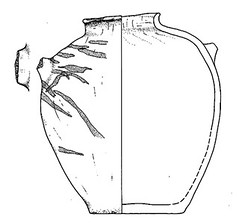
Grape Wine
Neolithic Wine!
A Momentous Innovation
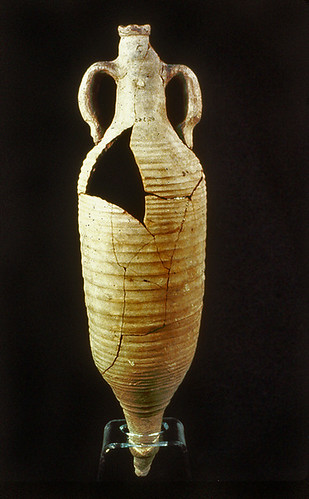
The earliest chemically attested grape wine in the world was discovered by my laboratory at Hajji Firuz in the northwestern Zagros Mountains of Iran, ca. 5400 B.C. (Early Neolithic Period). Six jars of the same shape, each with a volume of about 9 liters, were found lined up and set into the floor of a “kitchen” in a square mudbrick Neolithic house, which are similar in construction and design to the Neolithic structures.
Analyses of the two jars in the Penn Museum showed that they had contained a resinated wine or “retsina,” i.e., with terebinth tree or pine resin added as a preservative and medical agent. There was a red to go with the white wine, based on the colors of the residues.
The history of civilization is, in many ways, the history of wine, and the earliest stages of vinicultural history and prehistory extend back into the Neolithic period and beyond. In my book on Ancient Wine, I take the reader on a personal odyssey back to the beginnings of this consequential beverage when early humans probably enjoyed a wild grape wine. I follow the course of human ingenuity in domesticating the Eurasian vine and learning how to make and preserve wine some 7,000 years ago.
Early winemakers must have marveled at the seemingly miraculous process of fermentation. From success to success, viniculture stretched out its tentacles and entwined itself with one culture after another (whether Egyptian, Iranian, Israelite, or Greek) and laid the foundation for civilization itself. As medicine, social lubricant, mind-altering substance, and highly valued commodity, wine became the focus of religious cults, pharmacopoeias, cuisines, economies, and society. As an evocative symbol of blood, it was used in temple ceremonies and occupies the heart of the Eucharist. Kings celebrated their victories with wine and made certain that they had plenty for the afterlife. Some peoples truly became “wine cultures.” When we sip a glass of wine today, we recapitulate this dynamic history in which a single grape species was harnessed to yield an almost infinite range of tastes and bouquets.
I am currently collaborating on DNA sequencing of ancient yeast and grape with laboratories in Italy, Switzerland, Spain, and the U.S. The earliest preserved wine/bread/beer yeast (ca. 3150 B.C.) was identified at Abydos in Egypt (see Research on Egyptian Medicinal Wine), and modern Middle Eastern grape varietals from the Caucasus and eastern Turkey, crucial to determining where the Eurasian grapevine was first domesticated, were sequenced. It appears very likely that the wild Eurasian grapevine, Vitis vinifera sylvestris, was taken into domestication somewhere in the arc of mountains extending from the eastern Taurus across Transcaucasia to the northwestern Zagros.
Analyses of unique chlorite bowls and goblets from spectacular early Neolithic sites in eastern Turkey and very early pottery from Georgia are being carried out in collaboration with the U.S. Government Tax and Trade Commission Laboratory (Beltsville, MD). These areas were likely “hotbeds” of experimentation in the Neolithic period. DNA evidence supports the domestication of one of the Neolithic “founder plants”–einkorn wheat–in eastern Turkey, and chickpea and bitter vetch are also traced to this area, so why not the grapevine?
The upland areas of the Caucasus, Taurus, and Zagros Mountains are all possibilities for the earliest domestication and the beginning of winemaking. What especially makes me think that the origins of viniculture may be found here is that there is a great deal of archaeological and historical evidence for what can be called a “wine culture” gradually radiating out in time and space, from small beginnings in the northern mountains of the Near East in the Neolithic, to become a dominant economic, religious and social force throughout the region and later across Europe in the millennia to follow.
A new collaboration with the Helmholtz Zentrum München and the Institut Universitaire de la Vigne et du Vin-Jules Guyot in Dijon, using Fourier transform ion cyclotron resonance mass spectrometry, strongly supports the presence of reservatrol in an ancient wine sample. This compound is known to extend mammalian life expectancy.
I am now engaged in a new project at Lattes in southern France with Benjamin Luley and Michael Dietler of the University of Chicago, which has as its goal tracing the transfer of the “wine culture” to this area from ca. 600 B.C. onwards by the Phoenicians, Greeks, and/or Etruscans. In the centuries to follow, as viniculture spread to the rest of France, the implications for world winemaking and its culture were enormous.
I am also involved in analyzing and publishing archaeological materials from Ashkelon and two 8th c. B.C. Phoenician shipwrecks off the coast. I have carried out Neutron Activation Analysis of 60 pottery sherds from Ashkelon (bowls, jugs, amphoras, cooking pots, probable Chocolate-on-White ware, and Levantine Painted pottery) and Egyptianizing sealings of the enigmatic Middle Bronze IIA period, which are not yet published. The results will show that Ashkelon is the major trading partner with Tell el-Dab`a in the Nile Delta and most likely where the Hyksos originated (see my book, The Foreign Relations of the “Hyksos”: A Neutron Activation Study of Middle Bronze Age Pottery from the Eastern Mediterranean, Archaeopress, Oxford, 2000). Overwhelmingly, the pottery and sealings at Ashkelon were made locally; only a few sherds were imported from the Nile Delta and Cilicia.
My laboratory has identified and published the finding of resinated wine inside a Phoenician amphora in one of the 8th c. B.C. shipwrecks. From Ashkelon proper, we are testing residues from a probable Iron IA winepress and from enigmatic underground jars and other installations of late Iron Age date that might have been used to make “grappa” or for dyeing.
Fermented beverages have been preferred over water throughout the ages: they are safer, provide psychotropic effects, and are more nutritious. Some have even said alcohol was the primary agent for the development of Western civilization, since more healthy individuals (even if inebriated much of the time) lived longer and had greater reproductive success. This website introduces you to ancient wine-making practices in the Neolithic period, in ancient Egypt, and Mesopotamia. Visit the Origins and Ancient History of Wine website.
Ancient Wine: The Search for the Origins of Viniculture
by Dr. Patrick E. McGovern (Princeton University Press)
This book is the first comprehensive and up-to-date account of the earliest stages of vinicultural history and prehistory, which extends back into the Neolithic period and beyond. Elegantly written and richly illustrated, Ancient Wine opens up whole new chapters in the fascinating story of wine and the vine by drawing upon recent archaeological discoveries, molecular and DNA sleuthing, and the texts and art of long-forgotten peoples.
Resources
P. E. McGovern, U. Hartung, V. R. Badler, D. L. Glusker, and L. J. Exner
The Beginnings of Winemaking and Viniculture in the Ancient Near East and Egypt. Expedition 39/1: 3-21. 1997
P. E. McGovern, M. M. Voigt, D. L. Glusker, and L. J. Exner
Neolithic Resinated Wine. Nature 381 (June 6): 480-81. 1996
Genetic characterization and relationships of traditional grape cultivars from Transcaucasia and Anatolia. Molecular Ecology 15: 3707-14 (with R. Arroyo-Garcia, et al.) 2006
Genetic characterization and relationships of traditional grape cultivars from Transcaucasia and Anatolia. Plant Genetic Resources: Characterization & Utilization, 4.2: 144-58 (with J. F. Vouillamoz, A. Ergul, G. Söylemezo—lu, G. Tevzadze, and M. S. Grando). 2006
Evidence for S. cerevisiae Fermentation in Ancient Wine. Journal of Molecular Evolution 57: S226-232 (with D. Cavalieri, D. L. Hartl, R. Mortimer, and M. Polsinelli). 2003
Barley Beer
Barley Beer
Brewing up a Civilization in the Near East
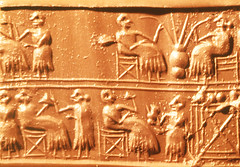
The earliest chemically confirmed barley beer to date was discovered at Godin Tepe in the central Zagros Mountains of Iran, ca. 3400-3000 B.C. (Chalcolithic/Late Uruk Period).
The artifact that my laboratory analyzed was the upper part of a large wide-mouthed jug in the Near East collection of the Royal Ontario Museum. A notched rope design decorated its exterior, including a knot, with loose ends hanging down, applied between two handles on one side of the vessel. A small hole had been punched through the body wall beneath the knot before firing. Our analysis of a sherd from the jug, with interior criss-cross grooves filled with yellowish material, showed that it was beerstone (or calcium oxalate), a byproduct of barley beer production.
The beer jug was found in the large central supply room of the Godin “Oval,” which was built on the Citadel as a military-cum-trading post in typical lowland architectural style by the proto-Sumerians and/or proto-Elamites along what has been interpreted as a “prehistoric Silk Road.”
It was associated with other important artifacts and botanical finds, including the then-earliest wine jars, pictographic tablets, sling-stones, carbonized barley and lentil and beveled-rim bowls for bread production from the supply room; two more wine jars and a large necklace of semi-precious stone jewelry found strewn across its floor from the adjacent “party chamber;” and “empty” wine jars, a probable wine press and a large funnel, all used in making wine, from a winemaking facility across the courtyard from the supply room.
The ancient Great Khorasan Road, the forerunner of the Silk Road, passed by Godin. It was used to transport wine, semi-precious stones, such as lapis lazuli from Afghanistan, metals including copper, silver and gold, and even such mundane goods as wood, unavailable in the Tigris-Euphrates valley, from the highlands to the lowlands. Much earlier, Palaeolithic humans probably followed the same route eastwards.
We know from later texts that beer–rather than wine or some other drink–was the most common beverage in lowland Mesopotamia. Even the upper class there would normally have drunk beer. Many varieties of beer were made and enjoyed: light, dark, and amber beers, sweet beers, and specially filtered beers.
The interior criss-cross grooving of the jug is very significant. Vessels are often decorated with incisions on the outside, but rarely on the inside; usually they were left rough or smoothed off. Based on the chemical finding of the yellowish resinous material in the grooves being beerstone, the most plausible interpretation of the jug is that it was used to prepare, store or serve beer. It might have been a prototype for the proto-Sumerian pictograph sign for beer (kaş) in which the jar-sign (dug) is shown with various horizontal, vertical, and criss-cross markings on the inside. The grooves also served the practical purpose of concentrating and collecting the bitter, even poisonous beerstone, which would otherwise have spoiled the brew. The six-row barley on the floor of central supply room, where the beer jug was found, was probably grown locally.
The hole beneath the applied rope knot had the likely purpose of accommodating a lone drinking-tube. We might imagine that the shamanistic headman of the Godin clan or the leader of the proto-Sumerian/Elamite trading party was given pride of place at some communal function. Others dipped their straws in through the hole at the top of the jug, but he had a special hole for threading his drinking tube down into the brew.
The Godin beerstone was chemically compared to a modern sample (scraped from inside a brew kettle at Dock Street Brewery in Philadelphia) and one from an ancient vessel almost certainly used to make barley beer. The latter was a New Kingdom Egyptian vessel in the Royal Ontario Museum. The jar, with its flared rim and rounded base, is commonly referred to as a beerbottle by Egyptologists. It was decorated with lotus petals and mandrake fruit in Egyptian Blue pigment. Based on tomb paintings and reliefs, it was used in a special “bread-and-beer” ritual.
R. H. Michel, P. E. McGovern, and V. R. Badler
1993 The First Wine and Beer: Chemical Detection of Ancient Fermented. Analytical Chemistry 65: 408A-413A.
R. H. Michel, P. E. McGovern, and V. R. Badler
1992 Chemical Evidence for Ancient Beer. Nature 360 (Nov. 5): 24.
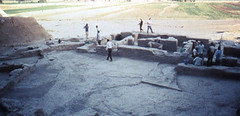
Midas
The Golden Touch of Midas

The first extreme fermented beverage that my laboratory discovered led to an exceptionally fine re-creation by Dogfish Head in 2000, namely Midas Touch. It all started with a tomb, the Midas Tumulus, in central Turkey at the ancient site of Gordion, which was excavated by the Penn Museum in 1957, over 50 years ago. The actual tomb, a hermetically sealed log chamber, was buried deep down in the center of the tumulus or mound, which was artificially constructed of an enormous accumulation of soil and stones to a height of some 150 feet. It’s the most prominent feature at the site. There was indeed a real King Midas, who ruled the kingdom of Phrygia, and either him or his father, Gordius, was buried around 740-700 B.C. in this tomb. There’s still some uncertainty, since there’s no sign announcing “Here Lies Midas or Gordius!”
When the Penn Museum excavators cut through the wall, they were brought face-to-face with an amazing sight, like Howard Carter’s first glimpse into Tutankamun’s tomb. The excavators first saw the body of a 60-65-year-old male, who had died normally. He lay on a thick pile of blue and purple-dyed textiles, the colors of royalty in the ancient Near East. In the background, you will see what really got us excited: the largest Iron Age drinking-set ever found–some 157 bronze vessels, including large vats, jugs, and drinking-bowls, that were used in the final farewell dinner outside the tomb. Like an Irish wake, the king’s popularity and successful reign were celebrated by feasting and drinking. The body was then lowered into the tomb, along with the remains of the food and drink, to sustain him for eternity or at least the last 2700 years.
All of the ideas about what our ancient ancestors were drinking–whether a wine, beer, or mead–come together in our research on the so-called King Midas funerary feast, because surprisingly all three were mixed together in the drink. The gala re-creation of the feast in 2000 was at the Penn Museum. Again based on the chemical evidence, a spicy, barbecued lamb and lentil stew, according to our chemical findings, was the entree, and it was washed down with a delicious Midas Touch. It was the first reconstruction of a burial feast based solely on the chemical evidence.
You might ask: where is the gold if this is the burial of Midas with the legendary golden touch? In fact, the bronze drinking vessels, including spectacular lion-headed and ram-headed buckets or situlae for serving the beverage, gleamed just like the precious metal, once the bronze corrosion was removed. So, a wandering Greek traveler might have caught a glimpse of this and was then inspired to concoct the legend.
But the real gold, as far as I was concerned, was what these vessels contained. And many of them still contained the remains of an ancient beverage, which was intensely yellow, just like gold. It was the easiest excavation I was ever on. Elizabeth Simpson, who has studied the marvelous wooden furniture in the tomb, asked me whether I’d be interested in doing the analysis. She didn’t have to say more. I just had to walk up two flights of stairs, and there were the residues in their original paper bags from when they were collected in 1957 and sent back to the museum. We could get going with our analysis right away.
What then did these vessels contain? Chemical analyses of the residues–teasing out the ancient molecules–provided the answer. I won’t go into all the details of our analyses, in the interests of the chemically-challenged. Briefly, by using a whole array of microchemical techniques, including infrared spectrometry, gas and liquid chromatography and mass spectrometry, we were able to identify the fingerprint or marker compounds for specific natural products.
These included tartaric acid, the finger-print compound for grapes in the Middle East, which because of yeast on the skins of some grapes will naturally ferment to wine, especially in a warm climate. The marker compounds of beeswax told us that one of the constituents was high-sugar honey, since beeswax is well-preserved and almost impossible to completely filter out during processing; honey also contains yeast that will cause it to ferment to mead. Finally, calcium oxalate or beerstone pointed to the presence of barley beer. In short, our chemical investigation of the intense yellowish residues inside the vessels showed that the beverage was a highly unusual mixture of grape wine, barley beer and honey mead.
You may cringe at the thought of mixing together wine, beer and mead, as I did originally. I was really taken aback. That’s when I got the idea to do some experimental archaeology. In essence, this means trying to replicate the ancient method by taking the clues we have and trying out various scenarios in the present. In the process, you hope to learn more about just how the ancient beverage was made. To speed things up, I also decided to have a competition among microbrewers who were attending a “Roasting and Toasting” dinner in honor of beer authority Michael Jackson (not the entertainer, but the beer and scotch maven, now sadly no longer with us) in March of 2000 at the Penn Museum.
I simply got up at the dinner, and announced to the assembled crowd that we had come up with a very intriguing beverage that we needed some enterprising brewers to try to reverse-engineer and see if it was even possible to make something drinkable from such a weird concoction of ingredients. Soon, experimental brews started arriving on my doorstep for me to taste–not a bad job, if you can get it, but not all the entries were that tasty.
Sam Calagione of Dogfish Head Brewery ultimately triumphed. Starting in 2000, Midas Touch has gone on to be the most awarded of any Dogfish brew, having garnered 3 golds medals, appropriately enough, in major tasting competitions to date, along with 5 silvers and a few bronzes tossed in for good measure. It just got another bronze at the GABF several months ago in Denver.
One footnote: the bittering agent used in Midas Touch was not hops (which was only introduced into Europe around 700 A.D.), but the most expensive spice in the world, saffron. Turkey was renowned for this spice in antiquity, and although we’ve never proven it, the intense yellowish color of the ancient residues may be due to saffron.
Fifty years ago, the University of Pennsylvania Museum of Archaeology and Anthropology began excavations at the ancient Phrygian capital of Gordion in central Turkey. Within six years, the expedition had made one of the most spectacular archaeological discoveries of the 20th century. In the largest burial mound at the site, they located what has since been identified as the tomb of Gordion’s most famous son, King Midas. This website recreates the funerary feast of King Midas according to the archaeological excavation of the Midas Mound in Yassihöyük Turkey. Visit the Funerary Feast of King Midas website
P. E. McGovern
2000 The Funerary Banquet of “King Midas.” Expedition 42: 21-29.
P. E. McGovern, D. L. Glusker, R. A. Moreau, A. Nuñez, E. Simpson, E. D. Butrym, L. J. Exner, and E. C. Stout
1999 A Funerary Feast Fit for King Midas. Nature 402 (Dec. 23): 863-864.
Chocolate
The Birth of Chocolate
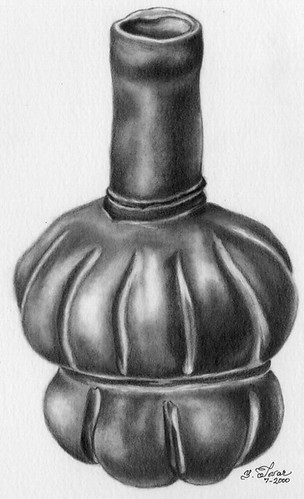
Our ancestors might well have brought traditions of how to make a fermented beverage with them to the New World, but they were also faced with harnessing the resources of a host of new plants– maize or corn, cacti of all kinds, manioc or cassava and squash, and much, much more. Chocolate or cacao is an excellent example of how a new alcoholic beverage was discovered and put to use, and likely led on to the domestication of the tree (Theobroma cacao = “food of the gods”).
A sweet pulp fills the warty-looking fruit of the criollo variety, native to Central America. This sweet pulp, with as much as 15% sugar, that might well have first attracted our ancestors. Fermentation of ripe fruit occurs naturally, and produces a 5 to 7% alcoholic beverage. In fact, the beans are still freed from the pod this way in modern chocolate production. The Spanish chroniclers observed that native peoples along the Pacific coast of Guatemala delighted in a mildly alcoholic beverage, which they made by piling cacao fruit into their dugout canoes and letting it ferment there.
The Puerto Escondido analyses of 11 pottery sherds support this scenario that a fermented beverage initially attracted humans to the tree. One vessel, a long-necked jar which tested positive for theobromine (uniquely found in cacao in Central America), advertised its contents: it has the shape and characteristic ridges and indentations of the cacao pod. This jar was likely filled with a fermented chocolate beverage made from ripe chocolate fruit.
Like grape wine, rice wine, and barley beer in the Old World, chocolate “wine” went on to become the prerogative of royalty and the elite generally, and a focus of religion in the New World. Cacao beans also served as money for the Aztecs, and King Montezuma had a veritable Fort Knox in his storerooms at Tenochtitlan–nearly a billion beans, according to one Spanish informant.
Many of the most stunning pottery vessels from Mesoamerica were made to hold the beverage.
In later Mesoamerica, the Mayans and then the Aztecs increasingly turned to the beans, rather than the fruit, to make their cacao beverage. They also mixed in lots of additives–honey, chilies of all kinds, variously scented flowers, and achiote or annatto (Bixa orellana) which colors the beverage an intense red in keeping with its association with human sacrifice. If a victim atop one of the pyramids faltered, he was given a gourd of chocolate, mixed with blood which had been caked on the obsidian blades of earlier sacrifices.
This later drink was often frothed to give a high head of foam. The idea was apparently to inhale the foam at the same time that one drank the liquid directly from the mouth of the vessel. The most distinctive vessel type for consuming the new chocolate drink was a “teapot” whose spout was bent backwards, impossible for pouring a liquid but serviceable for inhaling a foam.
Our research on ancient chocolate was carried out in collaboration with Jeff Hurst of Hershey Foods Technical Center. Another new collaboration, fitting our general research model of using state-of-the-art instrumention, is with Mattanjah de Vries at the University of California at Santa Barbara. He uses resonant ionization mass spectrometry to study the fingerprint compounds of cacao–theobromine and caffeine.
P. E. McGovern, J. S. Henderson, R. A. Joyce, G. R. Hall, and W. J. Hurst
2007 Chemical and Archaeological Evidence for the Earliest Cacao Beverages. Cover article of The Proceedings of the National Academy of Sciences USA 104.48: 18937-40.
Royal Purple
Royal Purple
The Dye of Gods and Kings
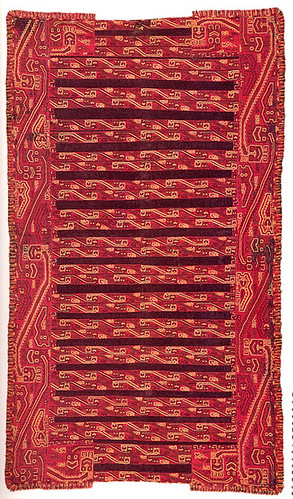
Paracas (Peru) mantle, ca. 200 B.C. – 200 A.D., dyed with molluscan purple.
My interest in the Phoenicians was especially piqued when amphora fragments, covered with an intense purplish coloration on their interiors, started turning up in the 13th century B.C. levels of the Sarepta (Lebanon) excavations. At another site, such sherds might be taken as a matter of course, perhaps due to staining by a manganese ore or an exotic fungus. But when you find them at a homeland Phoenician site, thoughts turn to the celebrated Tyrian or Royal Purple dye, which was worth more than its weight in gold and became the prerogative of priests and kings.
Even the names “Canaan” and “Phoenicia” likely derive from roots meaning “red” or “purple,” underlining the importance of dyed textiles in these societies. According to Greek legend, repeated by later writers, the dye was discovered by the Tyrian high god and king, Melqart, when he and the nymph Tyros went for a stroll on the Mediterranean beach with their dog. The dog chased ahead and bit into one of the mollusks that must have once littered the shore. It came back to its master, muzzle dripping with a purple substance. The discovery was not lost on Melqart, who immediately dyed a gown with the dye and presented it to his consort.
In fact, the first foray of our laboratory into what has been called biomolecular archaeology, so-named because it focuses on ancient organic compounds, was to put the Melqart legend to the scientific test. By applying a battery of analyses, we conclusively showed that the purple color inside the Sarepta amphoras was true molluscan Royal Purple or 6,6′-dibromoindigo.
This compound is produced in nature only by three Mediterranean species of Murex and Thais, as well as related mollusk species around the world. When the purple-colored sherds at Sarepta were found to be associated with piles of shells, special processing vats and heating facilities, we had an open-and-shut case for a purple-dye factory and the earliest evidence of Royal Purple. And like the legend claimed, it was from Phoenicia or more accurately, Canaan, as the region was known in the 13th c. B.C. Other piles of the same mollusks have been found elsewhere in the Mediterranean, but so far earlier evidence for intentional dye production, as would be evidenced by a factory or actual dyed textiles, has not emerged. The discarded shell piles elsewhere could represent the debris after eating the animals or stockpiling them for pottery or plaster manufacture.
Purple dyeing was also discovered by humans living and on the western and eastern shores of the Pacific Ocean in China and Peru, most likely independently of the Canaanites or Phoenicians. Species related to the Mediterranean mollusk there can also yield the color. Beginning as early as 1500 B.C. in the Mediterranean region, probably somewhat later in China, and about 700 B.C. in Peru, human beings discovered that by extracting the glandular contents in quantity and exposing the liquid to light and air, they were able to produce this unique color. Because it requires as many as 10,000 animals to produce a gram of the dye, it was also very expensive to make. In each civilization, the molluscan Purple dye eventually came to be associated only with the highest political authorities and was imbued with special religious significance. Kimonos were dyed entirely in Purple, and the extremely well-preserved textiles of the Paracas and Nazca cultures of Peru and northern Chile exhibit stunningly beautiful patterns in Purple. In 1st century Rome, Nero issued a decree that only the emperor could wear the purple–hence, the name Royal Purple.
Some might argue that a transference of dyeing technology from a more advanced culture (e.g., the Near East) to a more fledgling one (China or Peru) accounts for the available evidence. Another scenario is more likely for this example of convergent development, in keeping with Occam’s razor or rule, viz., the simplest, most straight-forward explanation is often the right one. It runs as follows. The mollusks with the purple dye precursors were probably also a source of food in each region. The Mediterranean species, for example, are still a great delicacy in France and Italy, and the Chinese are renowned for exploiting every food source in their environment. In removing the animal from its shell and preparing it to be eaten, the hypobranchial gland, which is located on the outside of the creature, is easily broken. Once the liquid has seeped out, it will immediately begin to change from a greenish liquid to purple on exposure to light and air. A shellfish-monger’s hands would soon be covered with the purple dye, which is one of the most intense natural dyes known and can only be removed by using a reducing agent. By no great leap of imagination, the Purple began to be collected and used as a dyeing agent. While this scenario may never be proven absolutely, it accounts for the archaeological data and is in keeping with human inventiveness.
Currently, we are now analyzing a textile, which was dyed purple, from an 8th c. B.C. Phoenician shipwreck off the coast of Ashkeon (Israel). From Ashkelon proper, we are testing residues from a probable Iron IA winepress and from enigmatic underground jars and other installations of late Iron Age date that might have been used to make “grappa” or for dyeing.
P. E. McGovern and R. H. Michel
1990 Royal Purple Dye: The Chemical Reconstruction of the Ancient Mediterranean Industry. Accounts of Chemical Research 23: 152-158.
1985 Royal Purple Dye: Tracing the Chemical Origins of the Industry. Analytical Chemistry 57: 1514A-1522A.
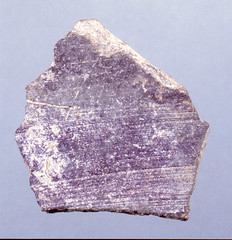
Ceramics
Ceramic Technology: The Inorganic Perspective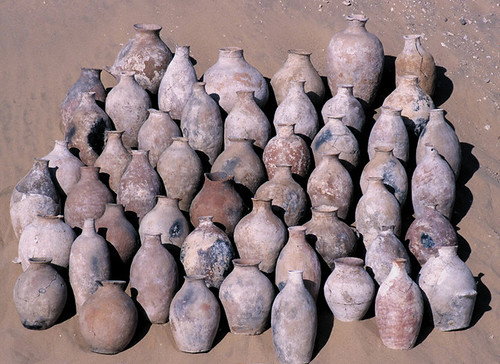 A representative sampling of the ca. 700 wine jars from the Scorpion tomb. (Photograph courtesy of German Institute of Archaeology, Cairo.)
A representative sampling of the ca. 700 wine jars from the Scorpion tomb. (Photograph courtesy of German Institute of Archaeology, Cairo.)
Before our laboratory embarked upon organic residue analyses to find out what ancient vessels contained, our focus was the inorganic containers themselves and how they were made from fired clay and silicate materials.
The form and decorative details of a pottery vessel are the end-products of a complex industrial sequence. The process begins with the selection and preparation of raw materials (clay and temper) and continues through a variety of formation techniques (e.g., definition of the body of the vessel, trimming of the rim and base, and the attachment of handles and appliqués), surface finishing (such as smoothing. slipping. or painting), and firing.
A standard typological analysis of an archaeological corpus assumes that the potter’s primary goal was to produce a particular form, which had been established by conscious and unconscious cultural traditions. From this perspective. pottery served definite functions within a society, whether as utilitarian or prestige items, and changes in style are seen as reflecting changes in the society as it interacted with its environment and other societies.
The emergence and subsequent development of a stylistic tradition. however, is conditioned by and can be very much dependent on underlying technological traditions. In general, any stage in the industrial sequence may impact on another stage in the same sequence. For example, the unavailability of high-quality raw materials or limited expertise in their preparation might inhibit the development of a wheel-throwing tradition. Form can also be a function of the decoration that is envisioned, whether expanding the shoulder space on a vessel for more elaborate painting or making a more open form that can be more efficiently slipped and painted.
In most cases, only finished pottery is available for study, which places a premium on complementary analytical techniques that can provide various kinds of data from which inferences can be drawn about the·production stages. If the ancient pottery manufacturing installations can be found or if the original raw materials are known, then the industrial sequence can be much more convincingly established, in conjunction with replicative experiments.
In the Molecular Archaeology Laboratory, a routine procedure has been developed for analyzing a corpus of pottery. The initial problem, especially for a group of finished pottery vessels, is to select a representative collection of specimens from a much larger corpus. The crucial factors at this stage will be primarily macroscopic criteria (vessel form, surface decoration, ware color, etc.), bearing some relation to the manufacturing process, and the results of previous investigations. Low-power microscopic observation (using a stereozoom scope with fiberoptic lighting, up to x 180) was an important adjunct in preliminarily defining wares, and formation and finishing methods. Specific ceramic questions are also posed at this level of analysis. The pilot study may resolve some of these questions: depending upon the analytical results, other questions may have to be recast or the sample size enlarged (which might be indicated by feedback arrows on the flow chan). As technological interpretations are progressively refined, cultural inferences are correspondingly strengthened.
It is most convenient initially to separate the xeroradiographic study of fabrication methods from the petrographic analysis. Although it is desirable to study many of the same samples by a combination of analytical. techniques, additional larger specimens from specific parts of a vessel, in particular the rim and base where there was the inevitable problem of what to do with excess or insufficient clay, often need to be X-rayed. The interpretation of inclusions and voids on a radiographic image can also be ambiguous, e.g., the lighter mineral inclusions such as calcite and quartz are essentially transparent to the X-ray beam (non-radiopaque) and indistinguishable from voids (except in the case of more angular shapes).
The petrographic analysis bears most directly upon the refiring and scanning electron microscopic (SEM) studies of the original firing temperature range, structural and chemical ware properties, and surface decorations (slips, paints, etc.) of the ancient pottery. For example, specific mineralogical changes, such as the transformation of green to brown hornblende at ca. 750̊C, provides evidence of the original firing temperature, and ware types are partly defined by their mineral suites. On this basis, a group of samples, representative of a ware type, was refired over a specific temperature range to delimit the original firing range for that ware type. Slips and other surface layers are best characterized structurally and chemically by SEM; their presence/absence, however, can often be established under low-power magnification by color and structural differences as contrasted with the body ware.
Our ancient ceramic program also routinely includes heavy mineral analysis, Instrumental Neutron Activation Analysis and X-ray diffraction–techniques that provide unique sets of data. It might also be argued that an ethnographic study of modern potters in the region under study is an essential component in reconstructing the ancient ceramic technology and its cultural import.
A separate analytical program has been developed for ancient silicates, employing SEM and PIXE for colorant identification.
Our laboratory has studied silicate and pottery artifacts from around the world, e.g., the Middle East (Baq`ah Valley in Jordan and Beth Shan in Israel; Dinkha Tepe in Iran), South America (Batan Grande in Peru), southeast Asia (Ban Chiang in Thailand), etc.
Please refer to the numerous Articles and Books on these subjects.
